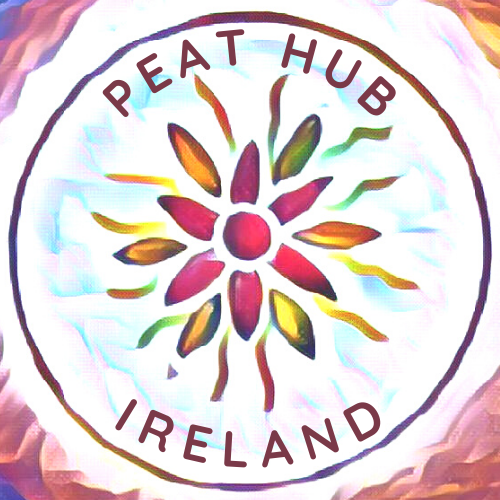Peatland Glossary
Peat Hub Ireland is a project funded under the EPA research programme 2021-2030. The Peat Hub Ireland Peatland Glossary comprises over 125 terms listed alphabetically relating to the sustainable management of peatlands in Ireland. The glossary is a living text which aims to provide access to up-to-date information, build shared understanding, and communicate new scientific knowledge and discovery about peatlands. Definitions were collated from a variety of national, European, and international sources, as well as submissions from a survey of Irish peatland researchers carried out in 2023.
| Term | Theme | Description | |
|---|---|---|---|
| Acrotelm | Biodiversity | The living, actively growing upper layer of a bog, the surface of which is composed mainly of living bog mosses. The presence of the acrotelm is vital to a raised bog as this is the peat-forming and water-storing layer of the bog. Suggestion for "Acrotelm" | |
| Active or peat forming | Peatland/Habitat type | According to the Interpretation Manual of the Habitats Directive, the term Active is taken to mean still supporting a significant area of vegetation that is normally peat forming. Suggestion for "Active or peat forming" | |
| Active peatland | Peatland/Habitat type | Peatland on which peat is currently forming and accumulating. All active peatlands (mires) are peatlands but peatlands that are no longer accumulating peat would no longer be considered mires. Suggestion for "Active peatland " | |
| Actor | Society and Culture | Entities with agency, i.e. the ability to choose or decide; they include people, communities, firms, other organizations, and states, but also some nonhuman organisms and their assemblages. Suggestion for "Actor" | |
| Afforestation | Land use | Conversion to forest of land that historically has not contained forests. Suggestion for "Afforestation" | |
| Agricultural peat soils | Soil | Areas of peatland used for agriculture, such as livestock or crop production. Suggestion for "Agricultural peat soils" | |
| Air quality | Air | Air quality is a measure of how polluted the air is. A range of air pollutants is emitted when peat is used as a fuel for electricity generation or for home heating, including fine particulate matter, which can penetrate deep into the lungs and airways with direct impacts on human health. Suggestion for "Air quality" | |
| Ammonia | Air | A pungent colorless gaseous alkaline compound of nitrogen and hydrogen that is very soluble in water and can easily be condensed to a liquid by cold and pressure. Suggestion for "Ammonia " | |
| Anaerobic | Soil | The absence of oxygen. Suggestion for "Anaerobic" | |
| Anthropogenic | Society and Culture | Resulting from or produced by human activities. Suggestion for "Anthropogenic" | |
| Appropriate Assessment | Management | A multi-staged process for ascertaining whether a plan or project, alone or in combination with other plans or projects, will adversely affect the integrity of the Natura 2000 Network of internationally important sites. Required under Article 6(3) of the Habitats Directive. Suggestion for "Appropriate Assessment" | |
| Artificial Light At Night | Pollution | The inappropriate or excessive use of artificial light at night. Manifesting as glare, skyglow, light trespass and light clutter. Suggestion for "Artificial Light At Night " | |
| Biocultural Diversity | Biodiversity | Biocultural diversity refers to the continuing co-evolution and adaptation between biological and cultural diversities. It also involves diversities of place and reflects people's ways of living with nature. This co-evolution has generated local ecological knowledge and practices across generations that allow societies to manage their resources sustainably while also maintaining cultural identity and social structures. Suggestion for "Biocultural Diversity " | |
| Biodiversity | Biodiversity | A general term used to describe all aspects of biological diversity including the number of species present in a given environment, the genetic diversity present within a species and the number of different ecosystems present within a given environment. Suggestion for "Biodiversity " | |
| Blanket Bog | Peatland/Habitat type | Ombrotrophic peatland type forming an extensive landscape in cool regions of high rainfall or humidity and a low level of evapotranspiration, allowing the peat to accumulate not only in wet hollows but over large expanses of undulating ground. Suggestion for "Blanket Bog " | |
| Bog | Peatland/Habitat type | Ombrotrophic peatland type with the surface above the surrounding terrain or otherwise isolated from laterally moving mineral-rich soil waters. Suggestion for "Bog" | |
| Bryophytes | Biodiversity | Mosses, liverworts and hornworts. Bryophytes reproduce from spores held in capsules, rather than seeds formed by flowers. Peatlands are home to a diversity of bryophytes, and bryophytes are important in the ecological functioning of peatlands. Suggestion for "Bryophytes " | |
| Carbon | Soil | A non-metallic chemical element with atomic number 6 that readily forms compounds with many other elements and is a constituent of organic compounds in all known living tissues. Suggestion for "Carbon
" | |
| Carbon balance | Soil | The sum of the amount of carbon taken up the growing peatland (i.e. the growth of the plants and the accumulation of the peat) and the amount of carbon removed from the peatland (i.e. gaseous losses (CO₂ and CO₄ emissions, dissolved C losses and losses due to human activities, such as turf cutting, fire, etc.). Suggestion for "Carbon balance" | |
| Carbon dioxide | Air | A heavy colorless gas that does not support combustion, dissolves in water to form carbonic acid, is formed especially in animal respiration and in the decay or combustion of animal and vegetable matter, and is absorbed from the air by plants in photosynthesis. Its chemical formula is CO₂. Suggestion for "Carbon dioxide" |

